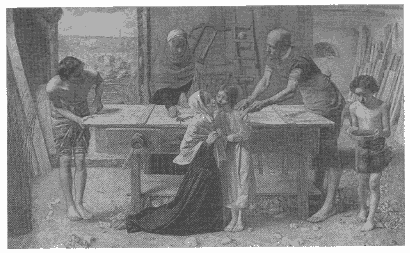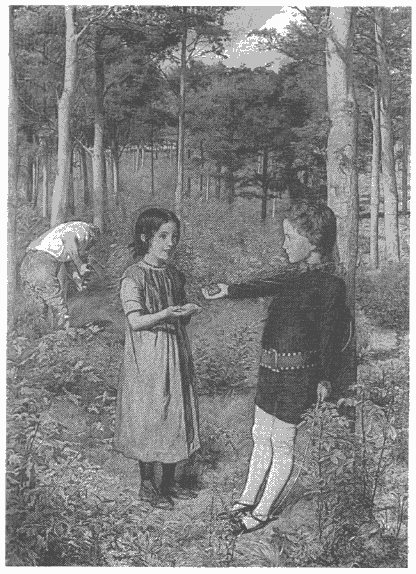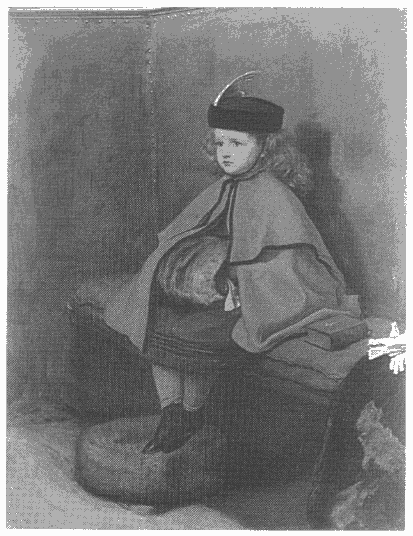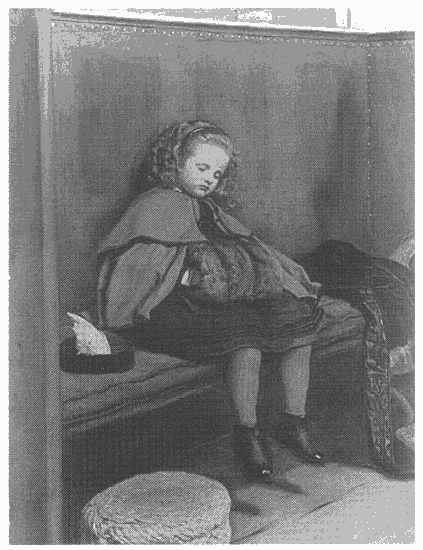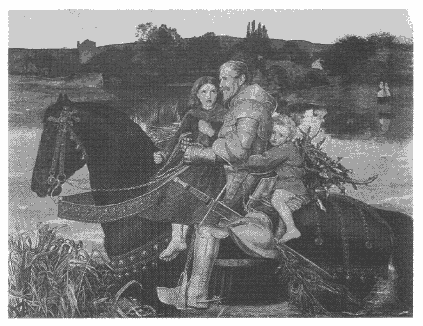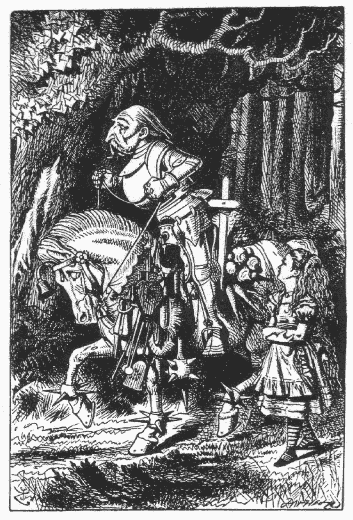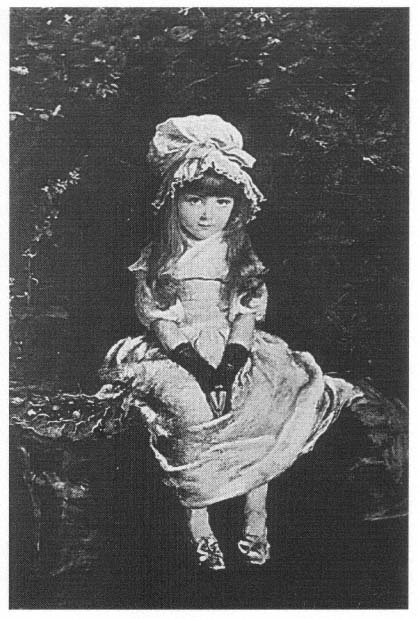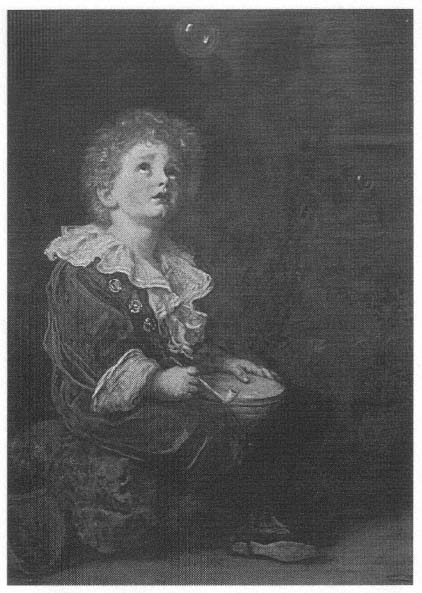John Millais's Children
Faith and Erotics:
The Woodman's Daughter (1851)
Robert M. Polhemus
I want to claim that John Millais did in his painting what Dickens did in the novel: made the child a crucial Victorian subject of faith, erotics, and moral concern, and imagined perceptions and conceptions of childhood that have great historical significance. Like Dickens, Millais was a chief and effective apostle in the development and rendering of what I call faith in the child, an emotional conviction, almost religious in nature and prevalent in modern civilization, that meaning, hope, value, and even transcendence can be found in children and our relationship to them. Like Dickens, Millais did nothing more important and far-reaching than take children as subjects and objects to represent. No eminent English painter before him had drawn so many or made them so central to his art. Tellingly, his landmark painting from the early development of the Pre-Raphaelite movement, the highly controversial Christ in the House of His Parents (1849–50; Fig. 87), shows Jesus as a typical Victorian working-class boy. Dickens, ironically, hated the picture, finding it blasphemous,[1] but historically it indicates perfectly how reverence for a supernatural God could be transformed into the representation of a realistically imagined child as a focal point of interest, concern, and—by implication—faith. Besides this picture, I refer in this essay to other famous Millais works featuring children from the span of his long career: The Woodman's Daughter (1851), A Dream of the Past: Sir Isumbras at the Ford (1857), My First Sermon (1863), My Second Sermon (1864), Cherry Ripe (1879), and Bubbles (1886), but I mean to concentrate on The Woodman's Daughter (Fig. 88), which I see as an image of especially radiant cultural meaning and importance.[2] It conveys a view of
children and their subjectivity that can be seen to have world-historical resonance.
Briefly, my argument about The Woodman's Daughter in particular and other Millais paintings of children in general is that (1) they render a new and intensifying fascination with childhood and the condition of children; (2) they express the strong cultural desire to idolize and aestheticize children, to identify faith with childhood, and to honor childhood as a time of innocence and potential virtue; (3) they make the well-being of children a touchstone of good; (4) they portray children as a desirable but time-doomed and menaced state of being and children as adorable, lovable, and beautiful but also appetitive, vulnerable figures requiring vigilant adult concern and responsibility; (5) they eroticize and sexualize childhood; (6) they represent the predictive power of children's experience for later life; (7) by juxtaposing the image of children with an explicit or implicit narrative text that extends chronologically beyond childhood and the depicted moment, they show childhood conceived of, and perceived from, a retrospect of adult knowledge, memory, and fate—in other words they depict childhood narratively and retrospectively in a way that opens up psychoanalytic points of view and insight; (8) they make problematic conventional ideas about "proper" social station and class division. The Woodman's Daughter especially illustrates how Victorian art and literature were forming and rendering the inseparability of faith in the child and a growing sense of the potential abuse and victimization of the child—shaping, that is, a projective and sacrificial role for the child in culture. And Millais, in this painting, better than in his later, more patently commercial and sentimental work, portrays the joy and pathos of childhood with a complexity that evokes many of the conflicts and contradictory feelings that childhood arouses in modern culture.
At first sight, it may seem surprising that Millais rooted this Pre-Raphaelite "Babes-in-the-Wood" in sordid sexual scandal and tragedy. He took his subject from Coventry Patmore's poem "The Woodman's Daughter,"[3] which tells the pathetic story of Maud, a country girl who, in the 1844 version of the verse narrative that the painter knew, gets pregnant by her upper-class lover, the squire's son, and drowns her baby and herself (Patmore, in subsequent shortened versions that he authorized for publication—see the Collected Poems [124–29]—retained the suicide, but suppressed the infanticide, having Maud drown herself before giving birth): "The shadow of her shame and her / Deep in the stream, behold!" Maud first appears as an industrious young woman at her spinning-wheel living happily with her old father, but then changes:
"And village gossips say she knows / Grief she may not avow." Then come the lines and images that Millais chose for illustration:
Her secret's this: In the sweet age
When heaven's our side the lark,
She follow'd her old father, where
He work'd from dawn to dark,
For months, to thin the crowded groves
Of the old manorial Park.
She fancied and he felt she help'd;
And, whilst he hack'd and saw'd,
The rich Squire's son, a young boy then,
Whole mornings, as if awed,
Stood silent by, and gazed in turn
At Gerald and on Maud.
And sometimes, in a sullen tone,
He offer'd fruits, and she
Received them always with an air
So unreserved and free,
That shame-faced distance soon became
Familiarity.
The poem, however, features childhood only in these three of its nineteen stanzas. It dwells on Maud's later despair at her ill-fated affair and on the act and natural setting for her watery suicide, whose details form a perfect "prequel" in theme, imagery, and tone for Ophelia (1852), Millais's masterpiece of the following year.[4] In the earlier painting, the threat of destruction from sex exists, but so does the potential for love, affection, and faith in the natural goodness and promise of childhood to dissolve the cruelties of sex, desire, and the inequities of social life. The picture anticipates the sexual disaster of the poem, refocusing it in childhood. We have here what is so often essential for faith, a morally and aesthetically appealing sacrificial victim who offers the hope of redemption. Religion, in the form of "suffer little children," is mixed with erotic love.
The Woodman's Daughter also anticipates Edward Burne-Jones's famous King Cophetua and the Beggar Maid (1884), which makes a mature, highly sexualized, lower-class virgin the object of a male gaze, aristocratic fixation, worship, and compulsive erotic desire.[5] Millais's stress on childhood experience as crucial and his projection of sexual and social drama in images of children are both original and striking. If we are fated to live in a world where early events shape life and character, a new focus on children might inform and possibly reform predetermined
stories of humanity that had been so often repeated. Set the picture next to the poem, and we can see that Millais portrays basic Freudian thought: childhood and its personal history of sexual desire appear as entwined determiners of fate. Moreover, Millais portrays the crisis of libido à la Marx, as inseparable from social history and class. The picture eroticizes and socializes childhood, even as it infantilizes social and personal erotics to bring them home. Newly emphasizing the representation of children's life, Millais sanctifies childhood as all-important.
The painting emphasizes both the spontaneous goodness and the erotic fixation of childhood. How, specifically, might we interpret it? Suspense hangs over the composition—moral suspense. The children are not yet lost. One viewer-response could be to feel that empathy with them and their condition might save such beings and better the world. The focus of positive moral feeling lies in the hopeful expression of the girl making friends with a boy of higher station and in his gesture, begrudging as it is, toward crossing the social chasm; more broadly it lies in the beauty of growing nature, including children, that fills the frame. Children, as Millais took pains to show, breed sentimentality, and sweetly optimistic readings are possible even if we know the gloomy poem. For example, Spielmann, the first serious Millais scholar, smugly writes (betraying his own class bias), "This charming illustration of the earlier verses of Coventry Patmore . . . gives no hint to the climax of the poem, that points the moral of the incompatibility of class and class" (89)—to which we might feel like responding "Not!" or "Bubbles!"
The picture can, however, be read as a hopeful and pretty bridge over the troubled waters of class. On one level, it may seem to offer a charming world where children act out innocently roles that in later life carry more disturbing meanings. We may find that the attractiveness of the children, to us and to one another, call imply a dissolving of class boundaries. Nature—good and happy nature—is stronger than culture. But when put in a cultural context, the picture can just as easily be seen as a pedagogy for seduction and an upper-class male's first exercise in propositioning a poor girl. The painting call imply a sophisticated knowledge of the sexual history of nobles and peasant girls, of chevaliers and woodmen's daughters; it suggests subjects and social patterns that a generation later would produce such reform agitation as William T. Stead's "Maiden Tribute of Modern Babylon" campaign to raise the age of female consent from thirteen to sixteen and keep working-class virgin girls from being sold into prostitution for rich men's pleasure.[6] It points up the power of class to destroy the natural feeling of children, the power of the male to exploit the female, the power of sexuality to inform
and ravage life. Victimization as well as virtue figures here: noblesse deceives as well as noblesse oblige.
Millais portrays faith in the child and potential corruption too in the bright, sinister wood of hereditary power and economic inequality. He is refiguring Eden and rendering the genesis of the Fall in childhood. The sire-gardener-woodman labors away, unable to protect the daughter, and the snake in the vivid green foliage is incipient sexual attraction fused with the trappings of wealth, which—not incidentally—have their own irresistible allure. The cold, beautiful, upper-class boy can be read as an original sinner, but possibly redeemable. He is shyly bribing this girl in her plain, spattered dress and work shoes. He looks as if he expects her compliance to his will. From one point of view, The Woodman's Daughter works on our sympathies like an ur-Save-the-Children poster. From another, it shows the promise that childhood and our concern for the flourishing of children carries with it: the faith, hope, and charity of natural religion. Help this nice girl might be one of its messages: If the world is to be good rather than evil, such a girl must flourish. Another might be This girl can save this boy.
Another message I read is Juvenile eroticism —infantile sexuality with its consequences —is the force that creates and ruins earthly Eden . The picture appeals to the desire for, and myth of, childhood innocence and, at the same time, suggests the unconscious power of the sexual imagination. The boy's stiff phallic arm holding the berries big with seed, the phallic tree against which he leans, the phallic switch in his hand, and the girl's cupped hands ready to receive the fruit show that the nineteenth-century child is not just father of the man and mother of the woman but, more particularly, father of the phallus and mother of the womb. The child is parent of both sexual destiny and the symbolic order. What seems daring and noteworthy is that Millais makes both children dramatic, seductive, libidinous subjects as well as objects, engaged with each other and with their erotic life, which is as real as the growing green things he paints. This girl and boy are sensual beings with a sexual life (the work, by the way, makes a mockery of the later, doubtful Freudian concept of "latency"). Not only are children objects of an appropriating gaze, as children are in so many later Millais pictures, but they are also here rendered as gazing, desiring beings. They fix on each other. Put quite simply, the picture shows that a child may be lovable and good but subject to the dangerous, animating fixation of her own and others' desires. A child's sexed and sexualizing life holds fate and faith in the balance. The effect of the picture is to render childhood precious, to reverence it, but also to show it as fleeting, erotic, and in need of protec-
tion. What we value as pure and loving can quickly change to what is impure, impious, and fallen. Childhood, like sex, is problematic and ambivalent: Is it innocent, candid, and full of love, like the girl, or grasping, gorgeous, proud, cruel, and spoiled, like the boy?
The nuanced Fascination of each figure with the other and the lack of touch—the distance—between the two stand out. The girl is dazzled by the boy, who looks at her in a calculating manner. Tension abounds between the virtue of the girl, representing the desire for intercourse among people whose good natures might overcome class harriers, and the imperiousness of the boy, who, intrigued and curious, wants homage and gratitude from the girl, wants some kind of an exchange with her, but hesitates to come close. His attitude is like that of a rich youth bargaining with a prostitute or a successful artist cajoling a model; it is a miming of ambiguous attraction, a tableau of seduction with child actors. Victorian children, like whores and models, could be procured; and such children, as the Pre-Raphaelites well knew, often grew up to be whores and models.
Here are inure of the thousands of words this picture might be worth: He: "I'm handsome, rich, fair, male, and dressed in all my red-white-and-blue finery—a little lord of creation. I carry concealed from you now a limber switch, a little weapon to wield as I like. I'm the keeper of fruit, the hearer of the seed, and hold enticing strawberries; take them, but if you think I'm going to demean myself, you have no sense of rank or privilege.
She: "Thank you. I like your regard. The fruit you offer cherry-ripe, cherry-ripe I'll eat. It looks delicious and so do you, the loveliest thing I've ever seen, Let's be friends, let's play, let's explore these woods as intimates. You're lonely and I'll make you happy. See, I've turned my back on my father and have eyes only for you."
The eye, says Joseph Brodsky, identifies not with the self's body and mind, "but with the object of its attention."[7] If that is true, our eye identifies with both the smitten, glamour-starved gaze of the girl and the cool evaluating gaze of the privileged boy. Millais's art here brings us to identify with their desire, not merely to objectify the images of these two children. Meanwhile, symbolic omens of Fallen nature and predatory death lurk obscurely in the sunny, pleasant scene of the present: the feathers of a dead bird at the boy's foot, the fat, doomed conies in the wood, the chopped stump in the foreground, and the tree about to be struck by the woodman's poised axe. Iconographically the woodman is both Father Time and the Grim Reaper, hewing away at growing life; for time and death, according to the poem, will soon cut down the
daughter. The girl in the composition is fixed between the blade of her father's swinging axe and the fatal fruit at the end of the boy's rigid arm: they make a sight line right through her heart.
The woodman himself, in Millais's perspective, is diminished in authority, a background figure looking small in relation to the idle, opulent boy. Labor and leisure contrast. Notice that the woodman grips a tool, but the boy holds fruit and a whip (almost literally "the carrot and the stick"). The only visible metal, often a symbol of masculinity in art, shows in the boy's belt buckle and in the woodman's axe head. Metal, here, signifies work fir the lower class, but ornament for the ruling class. The gaudily belted lad, leaning against a tree, has berries to give away, but the beltless laborer, lifting his powerful, veined arms in the service of property, has no fruit For his daughter. Intent on his work, unaware of, or complicit in, the drama of seduction behind him, the father must acquiesce passively, it seems, in whatever transaction is taking place. The demeaned parent is looking the other way.
The picture finely represents an important but much ignored subject: the relationship between class and sexual choice. As Patmore and Millais show us, there is no such thing as safe sex for the woodman's daughter. Sexuality, sexual freedom, sexual options, power, status, and money are deeply intertwined, as are violence, natural growth, pleasure, what you wear, color, and commodity transactions. The meanings and emotional rhetoric of the painting come through as inevitably various and mixed—even irreconcilable: Guard that nice girl! Don't take her virtue for granted. But still, she needs better clothes. Beware of that disdainful, pretty, scarlet boy and fantasize about him obsessively. Sex often means what power and wealth want you to do for them—or what they want to do to you—so watch out for the old erotic games of the privileged, see how and where they develop, and dream compulsively about them.
These children are fixated on one another, and erotic fixation—desire, libido—takes shape in childhood. That fixation comes both from curious, trusting good nature and from the selfish desire for mastery; it Comes from the codes of culture children must learn, and from the fascination with the other in social existence. It comes out of child psychology, in which, For example, the pleasure principle plays, the absence of the mother is present, the sexual parts and infantile concern about them figure but are imaginatively displaced, and the question of power is inseparable From desire.
Millais's later renderings of children, to my eye, rarely, if ever, convey the resonant subjectivity or psychological complexity of The Woodman's Daughter. My First Sermon (Fig. 89), For example, while ostensibly por-
traying the awe that orthodox religion can produce in a child, actually has the relatively simple effect of turning the girl into an icon and objective focus of faith. And in My Second Sermon (Fig. 90), Millais, though showing the ebbing power of Christian orthodoxy, maintains and strengthens the Focus of faith in the child and promotes sympathy, affection, and even identification with her. Both these pictures appear to show the child figure as an object of projection to arouse in viewers effects the painter has carefully calculated.
As opposed to The Woodman's Daughter, in A Dream of the Past: Sir Isumbras at the Ford (Fig. 91) the subjectivity lies in the figure of the adult. Sir Isumbras, one of Millais's most popular pictures (though its quality has been debated since it was first exhibited), clearly illustrates the cultural assumptions that children are good, appealing, and likely to be in need of salvation amid that the proper duty of the responsible knight (tested power amid moral authority personified) is to serve the child and to see that children flourish. Actually Sir Isumbras illustrates a bogus text written in false Middle English verse by Millais's friend Tom Taylor; it emotionally colonizes the Middle Ages for faith-in-the-child, projecting modern attitudes toward children's vulnerability, desirability, and centrality back in time.[8] The new Quixote, seeing the children in danger, moves to save them. But what is he saving them from, and why does he look bemused and just a little goofy? This painting, which John Tenniel obviously used in illustrating Lewis Carroll's Through the Looking-Glass (1871), is surely a main source of the White Knight in Carroll (Fig. 92), and it helped Dodgson-Carroll, who admired and photographed Millais, to imagine a comic yet noble role for himself as a literary knight-errant to Alice and to children generally. He identified completely with this figure amid the quest for serving children. Given Carroll's well-known passion and pure love for little girls, we can infer from Sir Isumbras the broad cultural phenomenon that faith in children amid the mission both to feature and protect them goes along with their eroticization amid its dangers. The good knight will rush to their rescue, but may look a bit foolish and faintly compromised.
Let me quickly compare The Woodman's Daughter with three other works: Dickens's David Copperfield (1848), which appeared just before the painting, and Millais's own Cherry Ripe and Bubbles .
Like Dickens in the young David—Little Em'ly part of Copperfield and the aftermath with Steerforth's seduction of Emily, Millais imagines childhood as both a prelude to, and a refuge From, sexual and social contamination—a presexual paradise being corrupted by class and in the process of erotic fall. In uncanny fashion, Millais seems to be illus-
trating precisely the spirit and effects of that section of Dickens and its tangled strands of infantile eroticism, faith, and sexual panic. Privileged-class David and lower-class Em'ly fall in love as children, and David recalls:
I am sure I loved that baby quite as truly, quite as tenderly, with greater purity and more disinterestedness, than can enter into the best love of a later time of life. . . .
As to any sense of inequality, or youthfulness, or other difficulty in our way, little Em'ly and I had no such trouble, because we had no future. We made no more provision for growing older than we did for growing younger.[9]
And in the joyous adult response to them Dickens illuminates brilliantly the kind of responses Millais's children might evoke: "We were the admiration of Mrs. Gummidge and Peggotty, who use to whisper of an evening when we sat lovingly . . . , 'Lor! wasn't it beautiful!' . . . They had something of the sort of pleasure in us, I suppose, that they might have had in a pretty toy, or a pocket model of the Colosseum" (40). The "admiration" gets at the conventional hopes that children embody; the "pretty toy" gets at the aesthetic sentimentalization of children; and then, unexpectedly, Dickens's odd, wild trope of the model "Colosseum," prime locus of sacrifice and the massacre of innocents, and a recreation center for a sexually dissolute, decaying civilization, uncovers the sacred, sacrificial, eroticized, and dangerous unconscious emotions playing about children that Victorian art can reveal.
Already falling into sexual retrospective hundreds of pages before he narrates the story of Steerforth's seduction and betrayal, David muses, "There has been a time since—I do not say it lasted long, but it has been—when I have asked myself the question, would it have been better for little Em'ly to have had the waters close above her head that morning in my sight; and when I have answered Yes, it would have been." We are dealing here with an influential brand of religious fanaticism featuring projection and ineluctably tied to the beauty of children, the longing for the innocence of childhood, sexual obsession, and the menace of sexual and class exploitation of maturing children.
I find a complementary and revealing fanaticism in a recent critical response to Cherry Ripe, upon whose figural child has been projected a libidinous subjectivity that makes her into a disturbing sex object (Fig. 93). Replying in Victorian Studies to Laurel Bradley, who contends this "pretty child" was "meant to embody positive attitudes of English culture" and suggests, with an ironic touch, that Cherry Ripe's "benign,
Madonna-like presence, multiplied through modern printing, spreads peace and goodness across both savage and civilized lands,"[10] Pamela Reis argues that Cherry Ripe's huge popularity was due also to its sexuality and "pronounced pedophilic appeal."[11] She writes:
The subject's bold gaze and half-smile are also sexual cues; she engages the viewer impudently, head on. Modern students of kinesic behavior, or body language, classify eye to eye contact accompanied by a smile as a sign of sexual invitation.[12] These visual signals, underscored by the title, legitimate the pedophile's desire. (201)
She adds in a footnote (205):
In cases of child molestation the perpetrator convinces himself that the child is not his victim but rather his complaisant and even eager partner [sic; Reis's masculine pronominal diction seems to show a priori sexist assumptions]. In a recent study of sex offenders by William L. Marshall and Sylvia Barrett we are told:
Just as many rapists think that women secretly want to be raped and are deliberately provocative, child molesters will often say that their victims' actions made it clear they wanted sex.[13]
Juxtaposing the crimes of rape and child molesting with the figure and subject of this painting, Reis continues:
Cherry Ripe's arms are "open," and, to make the message perfectly clear, her hands, pressed palm to palm between her parted knees, form a representation of female genitalia.
The darkness of Cherry Ripe's mitts emphasizes the salacious suggestion of her hands. . . . In Cherry Ripe . . . the dark mitts stand out, draw the eye to, and frame the little girl's hands, implying mature pubic hair around the depicted labia. . . .
My interpretation of Cherry Ripe rests solely on the evidence of sensuality I find in the picture. The child's smile and flirtatious gaze coupled with her hand arrangement held provocatively between the legs constitute a nonverbal request for sexual liaison. (203–04)
"Did Millais consciously pander to the imagination of the pedophile? I think not" (203), muses Reis, who goes on to say—begging a hundred questions—that the suggestive elements must have originated in "Millais's unconscious" (204). She concludes,
Unlike . . . Bradley, who sees reassurance in the "timeless purity of this quintessential English little girl," I see the disturbing presence of a saucy miss whose seductive portrayal grants sanction to the pedophile and provides titillation to those men and women, not attracted by children, who, nevertheless, enjoy the contemplation of sexually ardent femininity.
Astute though she is, Reis, like all critics, ascribes to others what she sces herself Here, she seems to be engaging in a common contemporary practice—replete with contradictions—with regard to children: that is, she in effect seeks to hang on to the ideal of a child's purity even while noting the sexual corruption of the child by adult desire; by so doing she indulges in the joys of iconoclasm, taboo breaking, and righteousness too. The artist (because he is unconscious of what he's doing), the model, and all of us right-minded, healthy viewers are let off the moral hook; the critic is exculpated (because she is above being seduced by the "seductive portrayal"); and some vague, nasty audience of others —pedophiles and the titillation-seeking voyeurs of "ardent female sexuality"—get the blame (never mind the weird twist of a logic by which the picture's sexuality appeals both to pedophiles and to those apparently turned on, not by children, but by sexually active women). Six hundred thousand copies of Cherry Ripe were sold to the public. Were all those Victorians really buying subliminal vaginal messages, perverse sanction, and sexual titillation? It is more likely they wanted icons of a secular religion and reassuring figures that, while not denying the existence and force of adult sexuality, appeared prior to, and free of, its psychological turbulence, its obsessions, its potential violence. Cherry Ripe, from my point of view, does intimate the inevitable eventual development of the child into mature sexuality, and it also has the complex double effect of stressing the beauties and refreshing simplicity of a pre-genital existence while implying that the child will grow up into a sexual future: it suggests a consistency and congruity for a whole human life. It claims, like The Woodman's Daughter —but without the earlier picture's particularity and complex resonance—that childhood is part of erotic history and that sexuality is destiny. But whether Reis and I are right or wrong or both, the really interesting thing may be why we see and say what we do.
I may agree or disagree with Reis and wonder about "nonverbal requests." I may condemn the potentially dangerous irresponsibility of scholars who blithely categorize "eye-to-eye contact accompanied by a smile as a sign of sexual invitation" (never go out shopping with such people!); and I may question the propriety of off-handedly associating the popular appeal of Cherry Ripe with rape and molestation. I may decide that Reis has or has not laid a glove on Millais. Nevertheless, in The Woodman's Daughter I still see erotic gazes, a phallic stiff-arm bearing seedy fruit, and gynecologically cupped hands. Why now are we looking for erotic connotations in Millais and wanting to stress that artists and writers have imagined the child sexually? Why do we make
little Magdalenes, Don Juans, and "Victorian centerfolds" of children? The various answers show important contradictions in our culture and ourselves. Writers, thinkers, and artists have made us more aware of the suffering and exploitation of children. The child has become a fine, appealing ideological figure and a concept onto which we can project our own identity and our own sense of virtue, violation, victimization, lost innocence, and—even—sacrifice. So how "they"—the profit-hungry artists, dealers, middlemen, and hegemonic voyeurs, say, or, more generally, unsympathetic "others"—are manipulating the image of the child can tell me, by analogy, what "they" have been trying to do to "me" and people like "me." Moreover, I can defend a faith: If it is just a matter of adult artists, writers, merchants, consumers, perverts, and bad, misguided people generally sexualizing the figure of the child for their own selfish reasons, maybe we can still hang on to a belief that children really are pure and good—worthy secular successors to such traditional figures of faith as the Virgin Mary and the saints. At the same time, however, I can be daring, advanced, provocative: If I speak of Cherry Ripe and The Woodman's Daughter in terms of "depicted labia," phallic imagery, and postpubescent sexuality, I might take comfort that I am exposing hypocritical, cultural idolatry and taking part in a big, progressive, disillusioning process against dangerously idealizing and reifying flesh and blood—doing the same kind of thing that Freudians analyzing Bernini's Ecstasy of St. Theresa did earlier, that a star sex tease does when she bills herself"Madonna," or that using the term "missionary position" can do.
It may be that religious feeling and idealization are inseparable from the erotic. It may also be that the very figuring of a child as a de facto icon of faith fetishizes the child, makes the idea of the child desirable, something to possess, something to love—and therefore a popular object of libido, cherry ripe for many kinds of exploitation. Millais, alluding to Cherry Ripe, reveals a cold cynicism about children and art that smacks of a new simony, the whoring of faith; he can use people's projections onto the child—sacred, profane, or whatever they are—to make money. He sounds like Chaucer's Pardoner: "For my part I paint what there is a demand for. There is a fashion going now for little girls in mob caps. Well, I satisfy this while it continues; but immediately the fashion shows signs of flagging, I am ready to take some other fashton."[14] He prostitutes his later art not so much to create a sexual fetish of the child as to create a vendible moral fetish and satisfy a nostalgic desire for innocence.
That brings us to Bubbles, whose subject is the innocence, beauty,
and fragility of childhood—a metaphorical bubble in time (Fig. 94). It portrays the child's vulnerability, as does The Woodman's Daughter, but the libido and the complexities of individual children are missing. The poor girl is gone, and the morally suspect rich child has become the soft, sweet bubble blower, a lovely fetish for sentimentalists and a perfect instrument of advertising (Pears' Soap bought the rights to Bubbles and famusly used this picture as a feel-good image to sell its product). Turning the child into a fetish of the good, however, denies children their own separate identities. However much we long to be pious or guiltless creatures of nature we are sensual, needy beings, living in the unstoppable torrent of time, like the little girl in My Second Sermon, who has fallen from pious pose into the physical world of heat, boredom, sleep, dreams, mutability, and materialism—or like the woodman's daughter, who is shown wanting to experience the berries and the boy. There is a psychological flaw in putting faith in the morally air-brushed child because, having all been children, we know somehow that, no matter how we lie to others and ourselves, we were never pure, never metaphysical, never angelic, and an innocent child is, in some dark recess of the psyche, what a perfect saint is—a falsehood, an impossibility, a moral reproach, and a condemnation of the self. Millais's faith has undergone a pharisaical conversion: a rich boy can pass right through the needle's eye of sentimentality.
According to Arthur Fish, "In the course of an interview Millais once expressed himself in these words on the question" why, in his later career, he painted for the most part "children of refinement, of good circumstance"—children such as the girl in Cherry Ripe and the boy in Bubbles:
I should like very much to paint a large devotional picture having for its subject "Suffer little children to come unto Me," I should feel the greatest delight in painting it, but the first question that occurs to me is, what children do we care about? Why, our own fair English children of course; not the brown simous-looking children of Syria. And with what sense of fitness could I paint our Saviour, bareheaded under the sun of Palestine, surrounded by dusky, gypsy-like children, or, on the other hand, translate the whole scene to England? The public is too critical to bear this kind of thing now, and I should be weighed down by the sense of unreality in treating a divinely beautiful subject.[15]
Faith in the child, we see, can easily go the way of other religious faiths into Philistine sellout, vicious intolerance, personal axe grinding, and murderous, abusive exclusion. But nothing so perfectly illustrates the arrogance and mean condescension of Millais's words as the expression
and figure of the boy in The Woodman's Daughter, where the child in retrospect turns out to be father to an aging, snobbish painter. After all, to give Millais his due, he did paint his version of "suffer little children to come unto me": two children fair and dingy, rich and poor, beautiful and common, open and shy, virtuous and sinful, naive and calculating, pure and spoiled, pious and fallen, virgin and sexually curious—for such are children in the kingdoms of the world. Suffer children would seem to mean, if it were to be a real article of faith, to cherish unsentimentally the individuality of children, to try to see them, in personal, social, and historical contexts as having their own points of view, to see their hungers and libidos, and to imagine with sympathy their awful joys and sacrifices and their immense potential for suffering and inflicting suffering. That is what The Woodman's Daughter looks to represent.
Fig. 87.
John Everett Millais, Christ in the House of His Parents, 1849–50. Oil on canvas,
34 × 55 in. The Tate Gallery, London, 1994.
Fig. 88.
John Everett Millais, The Woodman's Daughter, 1851. Oil on Canvas,
35 × 25 1/2 in. Copyright Guildhall Art Gallery, Corporation of London.
Fig. 89.
John Everett Millais, My First Sermon, 1863. Oil on canvas, 36 1/2 × 28 1/2 in.
Copyright Guildhall Art Gallery, Corporation of London.
Fig. 90.
John Everett Millais, My Second Sermon, 1864. Oil on canvas, 36 × 28 in.
Copyright Guildhall Art Gallery, Corporation of London.
Fig. 91.
John Everett Millais, A Dream of the Past: Sir Isumbras at the Ford, 1857.
Oil on Canvas, 49 × 67 in. Board of Trustees of the National Museums and Galleries on
Merseyside, Lady Lever Art Gallery, Port Sunlight.
Fig. 92.
John Tenniel, "The White Knight." Frontispiece to Lewis Carroll,
Through the Looking Glass and What Alice Found There, 1871.
Fig. 93.
John Everett Millais, Cherry Ripe, 1879. Oil on canvas. Photograph:
Bridgeman/Art Resource, New York.
Fig. 94.
John Everett Millais, Bubbles, 886. Oil on canvas, 43 × 31 in. Photograph:
Bridgeman/Art Resource, New York. Copyright A&F Pears Ltd., London.
